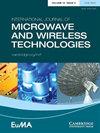Investigating electromagnetic scattering characteristics based on a nonlinear sea surface
IF 1.3
4区 计算机科学
Q3 ENGINEERING, ELECTRICAL & ELECTRONIC
International Journal of Microwave and Wireless Technologies
Pub Date : 2023-11-24
DOI:10.1017/s1759078723001253
引用次数: 0
Abstract
Establishing a precise electromagnetic scattering model of surfaces is of great significance for comprehending the underlying mechanics of synthetic aperture radar (SAR) imaging. To describe surface electromagnetic scattering more comprehensively, this paper established a nonlinear integral equation model with the Creamer model and bispectrum (IEM-C). Based on the IEM-C model, the effect of parameters, such as radar wave incidence angle, wind speed and direction of sea surfaces, and different polarization modes on the backscattering coefficients of C-band radar waves, was systematically evaluated. The results show that the IEM-C model can characterize both the vertical nonlinear features due to wave interactions and the horizontal nonlinear features due to the wind direction. The sensitivity of the sea surface backscattering coefficient in the IEM-C model to nonlinear effects varies with different incident angles. At the incident angle of 30°, the IEM-C model exhibits the most significant nonlinear effects. The nonlinear effects of the IEM-C model vary under different wind speeds. By comparing with the measured data, it is proved that the IEM-C model is closer to the real sea surface scattering situation than the IEM model.基于非线性海面的电磁散射特性研究
建立精确的表面电磁散射模型对于理解合成孔径雷达(SAR)成像的内在机理具有重要意义。为了更全面地描述表面电磁散射,本文利用Creamer模型和双谱(IEM-C)建立了一个非线性积分方程模型。基于IEM-C模型,系统评估了雷达入射角、海面风速和风向、不同极化模式等参数对c波段雷达波后向散射系数的影响。结果表明,IEM-C模型既能表征由波浪相互作用引起的垂直非线性特征,又能表征由风向引起的水平非线性特征。IEM-C模型中海面后向散射系数对非线性效应的敏感性随入射角的不同而不同。在入射角为30°时,IEM-C模型的非线性效应最为显著。在不同的风速下,IEM-C模式的非线性效应是不同的。通过与实测数据的比较,证明IEM- c模型比IEM模型更接近真实海面散射情况。
本文章由计算机程序翻译,如有差异,请以英文原文为准。
求助全文
约1分钟内获得全文
求助全文
来源期刊

International Journal of Microwave and Wireless Technologies
ENGINEERING, ELECTRICAL & ELECTRONIC-TELECOMMUNICATIONS
CiteScore
3.50
自引率
7.10%
发文量
130
审稿时长
6-12 weeks
期刊介绍:
The prime objective of the International Journal of Microwave and Wireless Technologies is to enhance the communication between microwave engineers throughout the world. It is therefore interdisciplinary and application oriented, providing a platform for the microwave industry. Coverage includes: applied electromagnetic field theory (antennas, transmission lines and waveguides), components (passive structures and semiconductor device technologies), analogue and mixed-signal circuits, systems, optical-microwave interactions, electromagnetic compatibility, industrial applications, biological effects and medical applications.
 求助内容:
求助内容: 应助结果提醒方式:
应助结果提醒方式:


